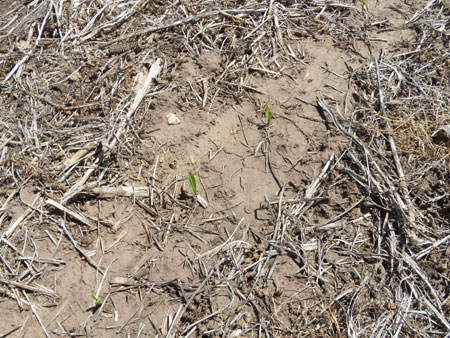Growing Degree Units and Corn Emergence
May 12, 2015

Many factors affect corn growth and development, especially early in the growing season. One that is not often discussed is how temperature affects days to emergence.
The National Agricultural Statistics Service reported Monday that 76% of the state's corn had been planted, but did not report on emergence. The May 3 report showed that although 57% of Nebraska's corn was planted, only 9% had emerged (USDA-NASS, May 4, 2015). Since corn emergence is directly related to soil temperature — and of course soil moisture — days to emergence vary, especially when one compares early planting dates to later planting dates. Figure 2 in the Iowa State University Integrated Crop Management article, How Long Will it Take Corn to Emerge, shows the impact of soil temperature on both corn and soybean emergence.
Downsides of Delayed Emergence
First, there is a downside to slower emerging corn. Planting corn into cool soils increases emergence variability, variation in plant sizes, and results in a wider spread in development stages. Variability in plant size – whether from cool soil temperatures and delayed emergence or from frost or other factors — will affect plant-to-plant competition and reduce yield.
Growing Degree Units (GDUs)
Growing Degree Days and GDUs refer to the same calculation based on air temperature. In the case of corn, the equation is:
GDD or GDU = (Daily Maximum Air Temperature + Daily Minimum Temperature)/2 – 50.
When the maximum air temperature is greater than 86°F, we set the value at 86° in the equation as the growth rate of corn does not increase beyond 86°F. Likewise, when minimum air temperature is less than 50 degrees, we set the value equal to 50 in the equation. The sum of daily GDUs or cumulative GDUs for corn emergence is approximately 90 to 120.
As a base line for GDUs required for corn emergence, colleagues at the University of Wisconsin report that 125 GDUs are required for emergence. Based on research in Iowa, corn typically required 90 to 120 Growing Degree Days (GDD) from planting to emergence (See Corn Growth & Development). This range assumes adequate soil moisture and will vary with planting depth, tillage system, and residue cover.
Adjustments for Management and Environmental Factors
Growing Degree Units are based on air temperature and not the soil temperature that impacts emergence. For this reason, several research reports document specific situations where adjustments may be made to help you fine tune expected emergence dates (Table 1) based on GDUs determined from air temperatures.
| Table 1. Potential impact of various management and environments that may alter corn emergence rates. (Source: Adapted from Corn Development, University of Wisconsin) | |||
| Management/ Environment | Specifics | GDU Adjustment | Sources |
| Residue | % In-row Residue Cover | 5 to 50 GDU | Swan et al., 1987 |
| Soil texture | Fine | Add 30-60 GDU | |
| Coarse | Subtract 30-60 GDU | ||
| Planting date | Before April | Add 10-25 GDU | |
| After May 15 | Subtract 50-70 GDU | ||
| Seed-zone soil moisture | Below optimum | Add 30 GDU | Schneider and Gupta, 1985 |
| Seed-bed condition | Soil crusting or massive clods | Add 30 GDU | Schneider and Gupta, 1985 |
| Seeding depth | For each inch below 2 inches ... | Add 15 GDU | Hunter and Kannenberg, 1972 |
| Severe drought or heat stress | Corn will not germinate until it absorbs 30% to 35% of its weight in water. | Abendroth et al, 2011. | |
| Seed treatments | Insecticides and fungicides | These may improve emergence percentage and perhaps emergence uniformity. If they improve plant to plant uniformity, they may hasten overall emergence in conditions listed elsewhere in this table. | |
| Hybrid | Hybrids with better emergence scores may emerge faster | Variable | |
| Schneider, E.C., and S.C. Gupta. 1985 Corn emergence as influenced by soil temperature, matric potential and aggregate size distribution. Journal Soil Science of America. 49:415-422. Hunter, R.B. and L.W. Kannenberg. 1972. Effects of seed size on emergence, grain yield, and plant in corn. Canadian journal of planting science. 52: 252-256. Swan, J.B., E.C. Schnieder, J.F. Moncrieg, W.H. Paulson, and A.E. Peterson. 1987. Estimating corn growth, yield, and grain moisture from air growing degree days and residue cover. Agron. J. 79:53-60. |
|||
In Nebraska and in the upper Midwest, the U2U decision support tool for corn GDD can be used to determine your local accumulated GDDs based on your planting date. As a rule of thumb, if 120 GDD have accumulated since planting and seedlings haven't emerged, check the condition of planted seed. Assess whether replanting is necessary.
Roger Elmore, Extension Cropping System Specialist and Robert B. Daugherty Water for Food Institute Fellow
Nathan Mueller, Cropping Systems and Ag Technologies Extension Educator
Online Master of Science in Agronomy
With a focus on industry applications and research, the online program is designed with maximum flexibility for today's working professionals.
